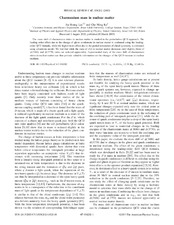| dc.creator | Lee, S. H. | |
| dc.creator | Ko, Che Ming. | |
| dc.date.accessioned | 2011-09-13T21:25:40Z | |
| dc.date.available | 2011-09-13T21:25:40Z | |
| dc.date.issued | 2003 | |
| dc.identifier.citation | S. H. Lee and Che Ming Ko. Phys.Rev.C 67 038202 2003. "Copyright (2003) by the American Physical Society." | en |
| dc.identifier.uri | http://dx.doi.org/10.1103/PhysRevC.67.038202 | |
| dc.identifier.uri | https://hdl.handle.net/1969.1/126930 | |
| dc.description | Journals published by the American Physical Society can be found at http://publish.aps.org/ | en |
| dc.description.abstract | The mass shift of charmonium states in nuclear matter is studied in the perturbative QCD approach. The leading-order effect due to the change of gluon condensate in nuclear matter is evaluated using the leading-order QCD formula, while the higher-twist effect due to the partial restoration of chiral symmetry is estimated using a hadronic model. We find that while the mass of J/psi in nuclear matter decreases only slightly, those of psi(3686) and psi(3770) states are reduced appreciably. Experimental study of the mass shift of charmonium states in nuclear matter can thus provide valuable information on the changes of the QCD vacuum in nuclear medium. | en |
| dc.language.iso | en | |
| dc.publisher | American Physical Society | |
| dc.subject | PAIR-CREATION MODEL | en |
| dc.subject | QCD SUM-RULES | en |
| dc.subject | BOUND QUARKONIUM | en |
| dc.subject | HEAVY MESONS | en |
| dc.subject | WILSON LOOP | en |
| dc.subject | J/PSI | en |
| dc.subject | ABSORPTION | en |
| dc.subject | DECAYS | en |
| dc.subject | DISSOCIATION | en |
| dc.subject | TEMPERATURES | en |
| dc.subject | Physics | en |
| dc.title | Charmonium mass in nuclear matter | en |
| dc.type | Article | en |
| local.department | Physics and Astronomy | en |


